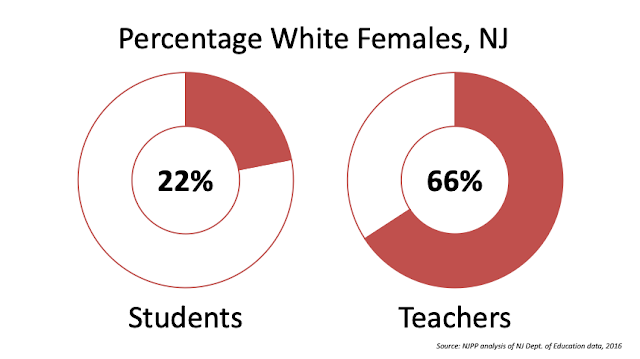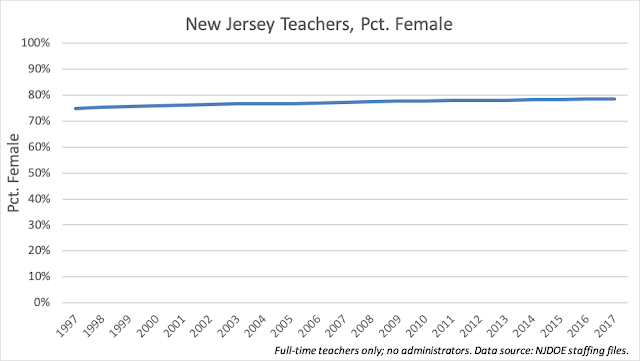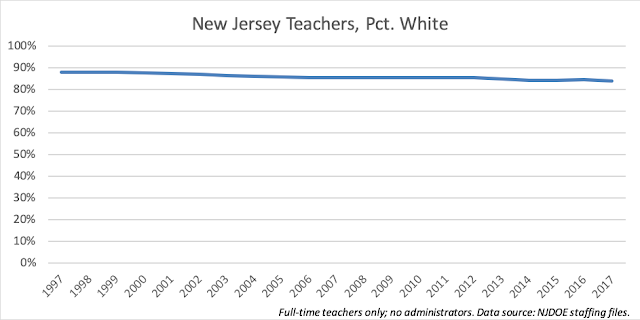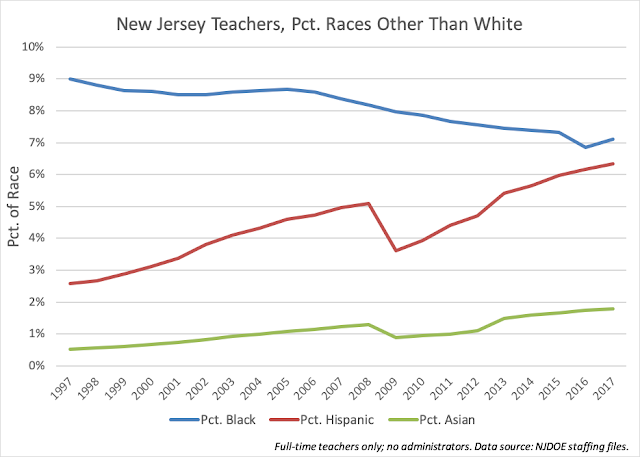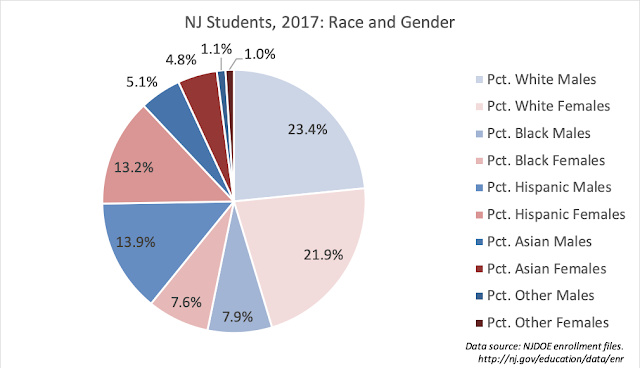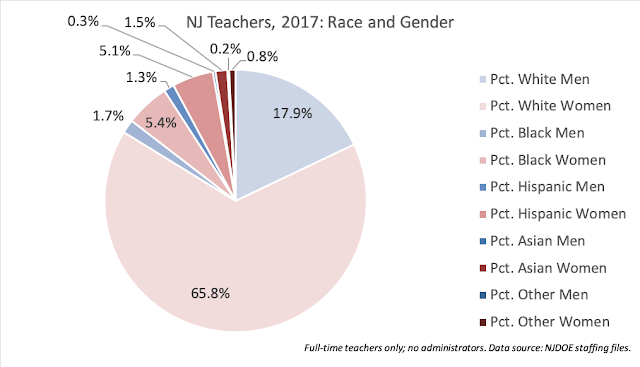Jersey Jazzman: The State of New Jersey's Teachers, Part 2: A Failure To Achieve Diversity
I'm breaking down my new report for the New Jersey Policy Perspective on New Jersey's teachers in a series of blog posts:
Part 1: Teachers, Aging, & Pensions
* * *
This graph is from the "short" version of my new report on New Jersey's teachers:
About 1 in 5 students in New Jersey is a white female -- but two-thirds of NJ's teachers are white females. Our teaching corps looks nothing like our student population.
Before I dive deeper into the data, let me first answer the obvious question: Why should we care? Does it matter that our teachers are overwhelmingly white women?
In fact, we have more and more evidence that it does, and I share a short summary of this evidence in my report. Among the studies I cite:
Colette N. Cann, 2013: This article has an excellent review of the research on teacher-student racial alignment:
In the area of race matching, Dee (2004) examined how the racial background of teachers contributes to the academic performance of students— particularly Black students. He found that Black and White students both performed better with teachers of the same race possibly because same-race-matching of students and teachers provided positive role models for students and reduced racist teacher practices that adversely affected student performance.
Eddy and Easton-Brooks (2011) looked at whether having an African American teacher increased the mathematics performance of Black students from kindergarten through fifth grade. Using data from 1,200 students in the Early Childhood Longitudinal Study, kindergarten through fifth grades (ECLS-K-5), they found that racial matching mattered to mathematics scores for Black youth (although they didn’t find any differences by gender, socio-economic status, or racial composition of the school).
Other studies have shown that there is a statistically significant and important relationship among the race of the teacher, the race of the student, and academic performance. Easton-Brooks et al. (2010), as cited in Eddy and Easton-Brooks (2011), found that the performance of Black youth in reading was higher if students had at least one Black teacher between kindergarten and fifth grade.
Egalite, Kisida, and Winter, 2015:“We find small but significant positive effects when black and white students are assigned to teachers of their own race/ethnicity in reading and when black, white, and Asian/Pacific Islander students are assigned to teachers of their own race/ethnicity in math.
We also examine the effects of race matching by students' prior performance level, finding that lower-performing black and white students appear to particularly benefit from being assigned to a race-congruent teacher."
Lindsay and Hart, 2017: “We find consistent evidence that exposure to same-race teachers is associated with reduced rates of exclusionary discipline for Black students. This relationship holds for elementary, middle, and high school grade ranges for male and female students, and for students who do and do not use free and reduced-price lunch. Although we find reductions in referrals for a number of different types of offenses, we find particularly consistent evidence that exposure to same-race teachers lowers office referrals for willful defiance across all grade levels, suggesting that teacher discretion plays a role in driving our results."
Look, I don't think it's a good idea for black students to only have black teachers, and white students only have white teachers, and girls only have women teachers, and so on. But I do think we've got to have a teaching workforce that looks like our student body. Even if we didn't have all this evidence that teacher diversity helps student achievement, it's enough to say that teacher diversity is important because we want our schools to reflect the best values of our society -- and that includes prizing people of all different backgrounds.
But in New Jersey, we're not doing a very good job at creating a diverse workforce for our schools. Let's start with gender:
4 out of 5 New Jersey teachers are women. To those who still contend teaching is a well-paid profession (we'll get to this topic next), let me ask you this: why aren't men flocking to the profession? I mean, if it pays so well, and has such awesome job security, you'd expect the teaching corps to be getting more male, not less. But exactly the opposite is happening.
And, again: it's not just women who dominate teaching, it's white women.
There's been a very small decline in the percentage of teachers who are white; still, over 4 in 5 teachers are white as of 2017. How the other races are represented in the teaching corps is interesting:
Let me first note that race and ethnicity in the teacher workforce is defined by seven categories: White, Black, Hispanic, Asian, Native American, Pacific Islander/Native Alaskan, and Two or More Races. The number of teachers in these last three categories is so small I didn't include them in this analysis.
Over the last two decade, the percentage of Asian teachers has gone up very slightly. The proportion of Hispanic teachers has grown a bit more substantially. But the percentage of Black teachers, which was only 9 percent anyway in 1997, has gone actually down.
This is discouraging, and we need to figure out why. Is the barrier to entry too great? Are there increasingly better opportunities than teaching for black college graduates? Are school districts just not hiring as many black teachers? We probably can't get to the answers through data analysis; we're going have to start doing some qualitative research into this question (and I'm going to have to start digging more through the literature to see what we already know).
Let's finish by looking at the entire student population of New Jersey, and compare it to the teacher population. Here are the students as of 2017:
And here are the teachers:
Notice how very few men of color are teachers; it's really remarkable, considering how many Black and Hispanic male students we have.
A reporter asked me the other day whether I thought the outreach programs at teacher training institutes, especially universities, could help. I said it couldn't hurt... but let's be honest: not many talented young people of color will seriously consider a teaching career if they have other, more lucrative prospects in the labor market.
Why would we expect graduates of color to react to economic forces differently than white college graduates? Don't they have the same student loans to pay off? Don't they have the same ambitions to lead happy, prosperous lives? Attracting more people of color and men to teaching starts with making the profession itself more attractive -- and that includes good compensation.
So let's talk about teacher pay in New Jersey next...
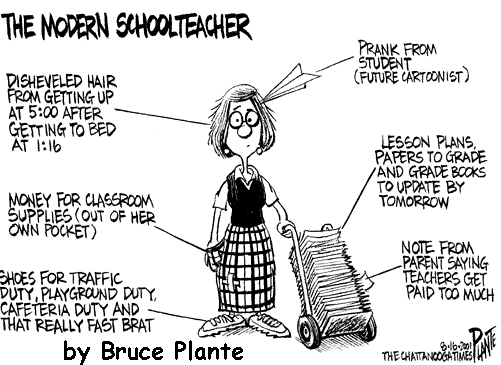
This blog post has been shared by permission from the author.
Readers wishing to comment on the content are encouraged to do so via the link to the original post.
Find the original post here:
The views expressed by the blogger are not necessarily those of NEPC.
